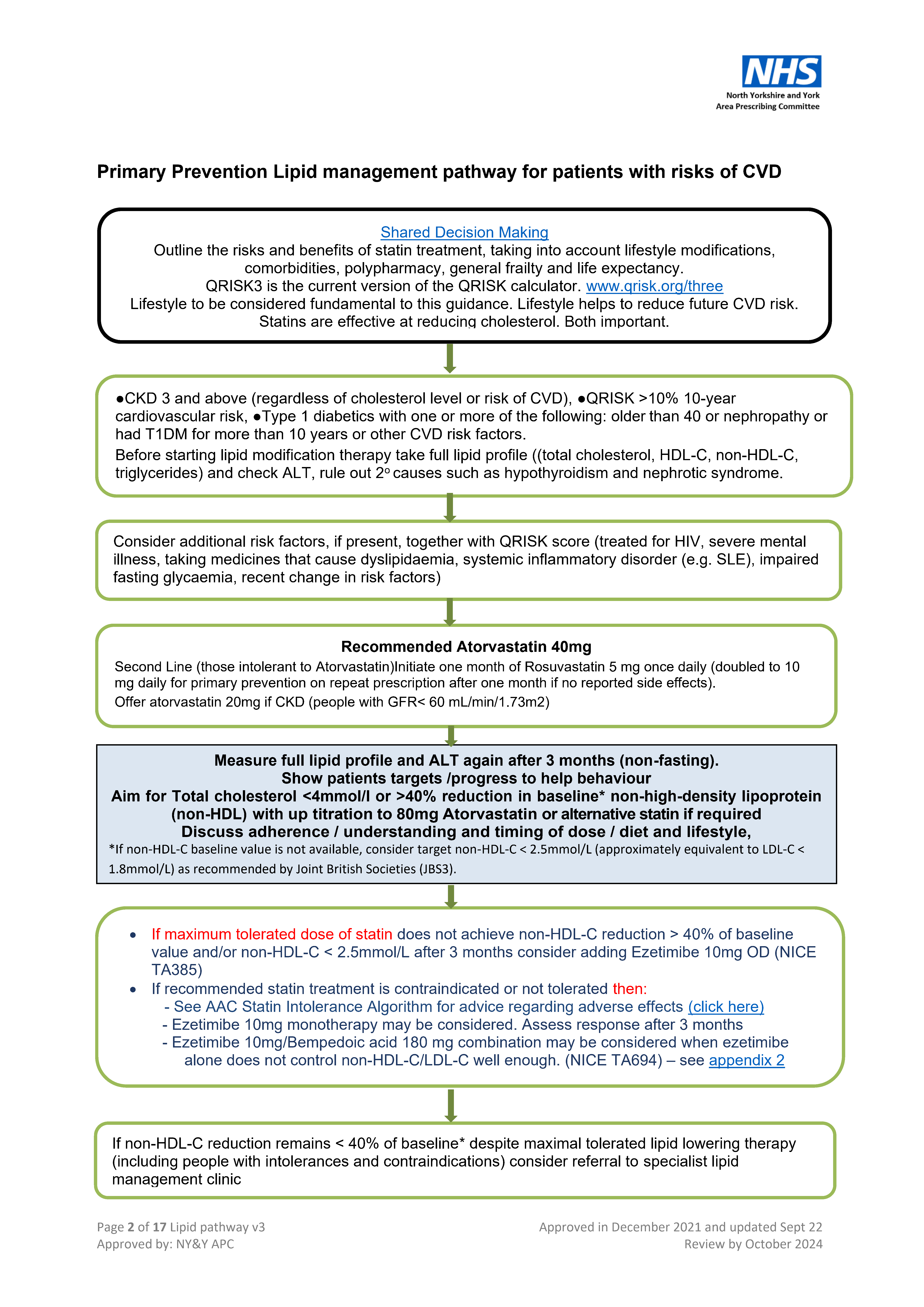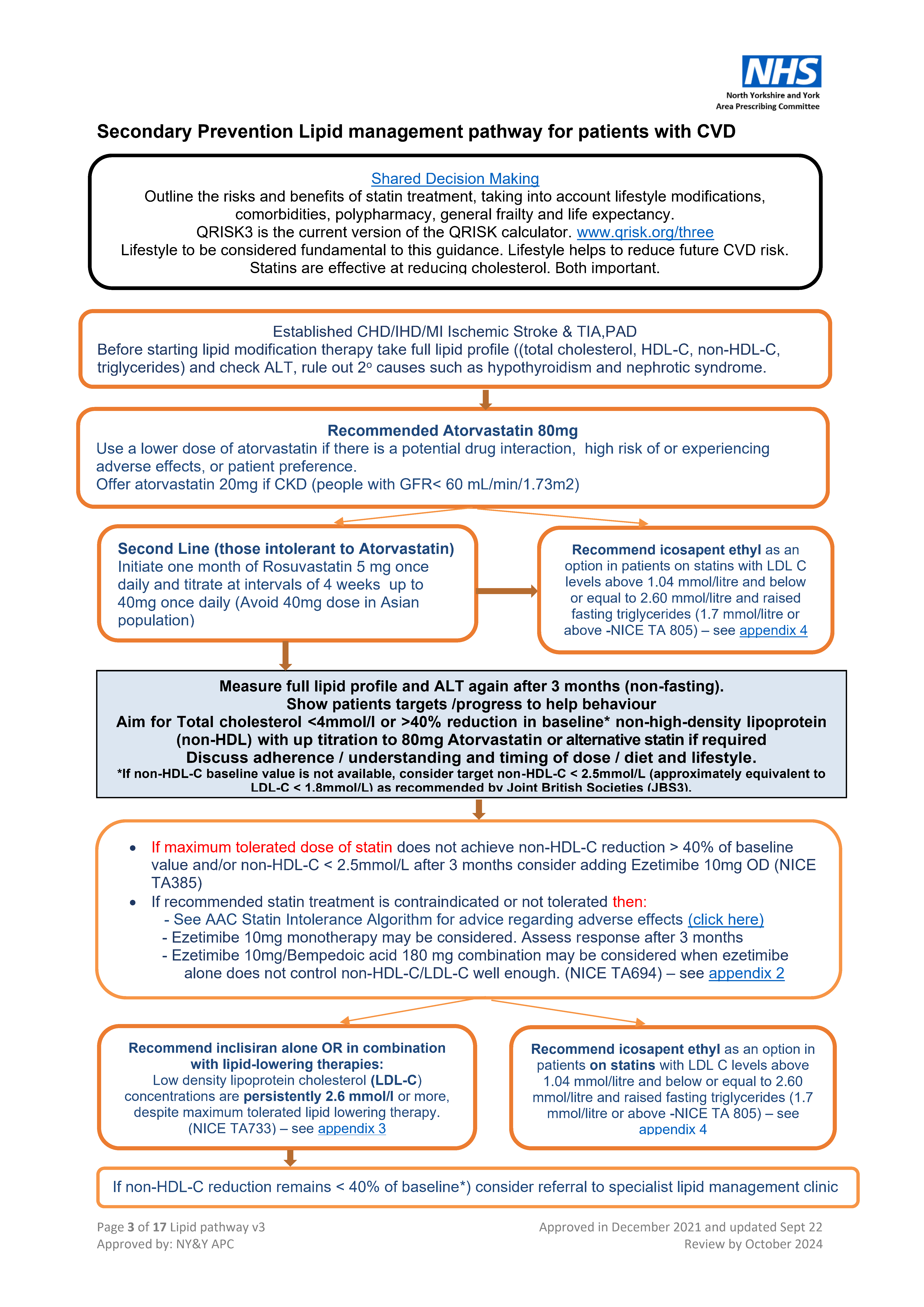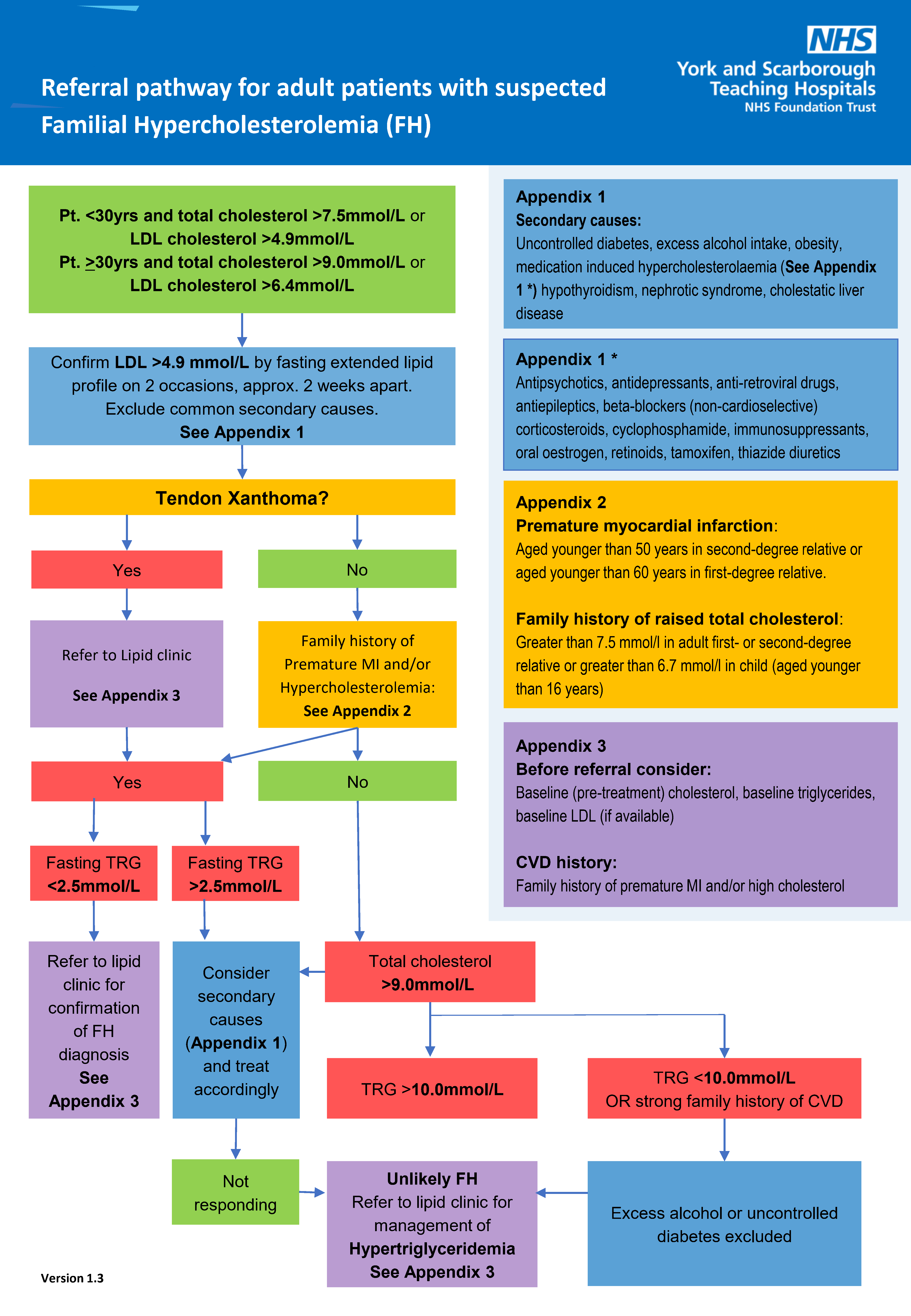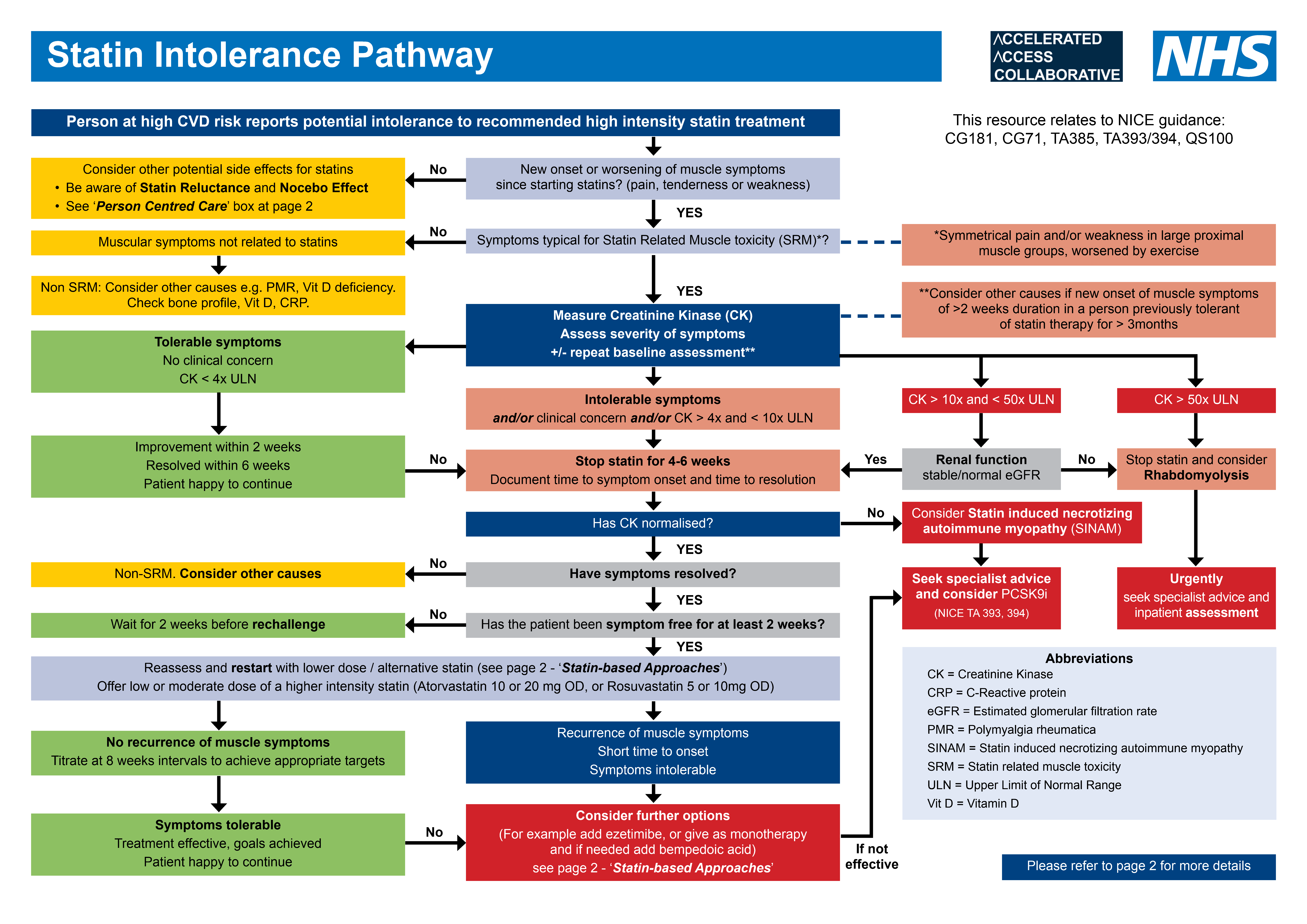Lipid disorders
Definition/Description
Patient has an abnormal lipid profile or is being treated because they are considered to be at high risk of or have existing cardiovascular disease.
Cardiovascular disease includes angina, heart attack, stroke, TIA and peripheral vascular disease.
Red Flag Symptoms
Exclude the following
- People under 16
- People who are allergic to statins
- People with an estimated life expectancy of less than 2 years
- Statins are contraindicated in pregnancy and should be discontinued 3 months before pregnancy and restarted after breastfeeding has finished.
Guidelines on Management
General points
- High cholesterol causes cardiovascular disease and accounts for a third of all heart attacks.
- Lifestyle change is key to cholesterol lowering. Where this is ineffective or in people at highest risk (e.g. pre-existing CVD or familial hypercholesterolaemia (FH)), drug therapy with statins and other medications is very effective.
- Every 1mmol/l reduction in low-density lipoproteins (LDL) cholesterol reduces risk of a cardiovascular event by 25% (Ref: Lancet, 2016, Interpretation of the evidence for the efficacy and safety of statin therapy, Collins et al)
- People with high cholesterol who also have other risk factors (e.g. high blood pressure, diabetes, smoking) are at significantly greater risk of CVD and have most to gain from a reduction in cholesterol.
- People with high triglycerides exclude secondary causes: excess alcohol intake, poorly controlled/ new diabetes, metabolic syndrome, certain medicines eg corticosteroids, estrogens, tamoxifen, psychotropic medicines, isotretinoin.
Management guidelines
- Management of lipids should be in the context of a formal risk assessment made using QRISK3 or JBS3 and medication started in the context of risk reduction according to the patient's informed opinion.
- Cardiovascular risk assessment tools should not be used in people with Type 1 diabetes, CKD with eGFR <60ml/min/1.73m2, known Familial Hyperlipidaemia and existing CVD.
- Lifestyle advice in the context of weight optimisation, diet, physical activity, smoking cessation are an integral part of the consultation; however for the majority, a low-fat diet will have only a minor (<10%) effect on lipid levels.
- Improving diabetes control and reducing alcohol intake should be a target for management.
- NICE Guidelines do not recommend the use of fibrates, omega 3 fatty acids, plant stanols or sterols in the context of cardiovascular risk reduction.
Use of statins for cardiovascular risk reduction
- As a class, statins are the most highly studied therapy and have revolutionised the prevention and management of cardiovascular disease.
- NICE Guidance recommends the use of a high-intensity statin when the decision has been made with the patient to use medication.
- NICE guidance recommends the use of atorvastatin for those estimated to be at >10% ten-year risk, people with CKD, those over the age of 40 with type1 diabetes, people with type 2 diabetes over 10% risk, and those with established cardiovascular disease.
- North Yorkshire and York APC recommendation:
Secondary Prevention = 80mg of atorvastatin
Primary prevention = 40mg of atorvastatin- Use a lower dose of Atorvastatin if there is a potential drug interaction, high risk of experiencing adverse effects, or patient preference.
- Offer Atorvastatin 20mg if CKD (people with GFR< 60 mL/min/1.73m2).
Follow up and potential complications of treatment
- It is important to discuss the risks and benefits of statin therapy and individualise the advice
- Community pharmacists can offer support when new prescriptions are issued in the form of the New Medicines Service.
- NICE guidance recommends follow up at 3 months after commencing a statin, with lipid profile and liver enzymes (ALT). This does not need repeating unless dose has increased, or kidney function has declined.
- If the target of > 40% non-HDL lowering is not achieved:
- Discuss adherence
- Optimise diet and lifestyle measures (including alcohol intake)
- Consider increasing the dose if taking less than atorvastatin 80mg and at high risk
- If statin is not tolerated, follow statin intolerance pathway and consider alternative lipid lowering medicines such as ezetimibe etc in line with the treatment pathway.
Referral Criteria/Information
Recommended Criteria for Referral to Lipid Clinic
Hospital lipid clinic |
Referral Criteria |
Severe hypercholesterolaemia |
Cholesterol >9.0 mmol/L (or non HDL-C > 7.5 mmol/L) regardless of existing heart disease / family history |
Cholesterol>7.5 mmol/L and LDL-C >4.9 mmol/L AND
|
|
Family screening |
Cascade screening from identified patient with familial hypercholesterolaemia with a genetic diagnosis of FH |
Severe Hypertriglyceridemia |
|
Unable to meet target reductions in LDL-C or non HDLC despite maximal doses of statins and other lipid lowering medications. |
|
Intolerance of 3 or more statins |
Additional Resources & Reference
Shared decision-making resources
Adverse events per 10,000 people taking statin for 5 years |
Events avoided |
Avoidance of major CVD events in patients with pre-existing CVD & a 2mmol/l reduction in LDL |
1000 |
Avoidance of major CVD events in patients with no pre-existing CVD & a 2mmol/l reduction in LDL |
500 |
Adverse events per 10,000 people taking statin for 5 years |
Adverse events |
Myopathy |
5 |
Haemorrhagic Strokes |
5-10 |
Diabetes Cases |
50-100 |
Links
Statin Intensity table
|
|
||||||||||||||||||||||||||||||||||||||||||||||||||||||||||||||||||||||||||||||||||||||||||||
Reference
North Yorkshire and York Lipid Guidance - above information sourced from here, please also find additional information on this link as well.
Additional resource
National Guidance for Lipid Management
Pathways
Associated Policies
Specialties
Places covered by
- Vale of York
Hospital Trusts
- York and Scarborough Teaching Hospitals



